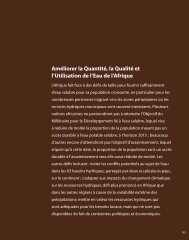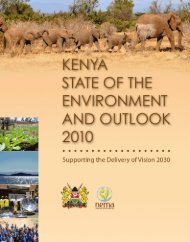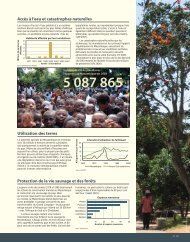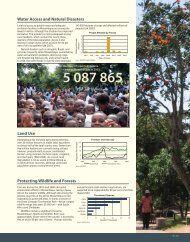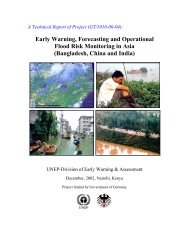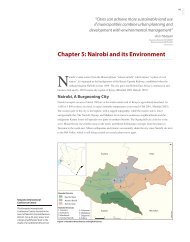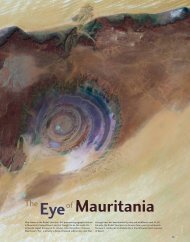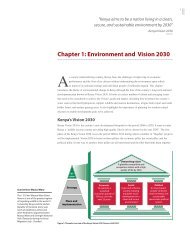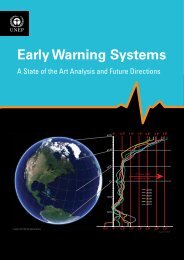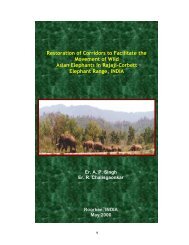Uganda Atlas of Our Changing Environment - GRID-Arendal
Uganda Atlas of Our Changing Environment - GRID-Arendal
Uganda Atlas of Our Changing Environment - GRID-Arendal
You also want an ePaper? Increase the reach of your titles
YUMPU automatically turns print PDFs into web optimized ePapers that Google loves.
Shifted bridge as result <strong>of</strong> flooding on Ebemi stream along the Laropi-Dufile Road<br />
Rivers/streams<br />
The River Nile is fed by several perennial/seasonal streams<br />
such as Amua, Chala, Ebemi, Aburiji and Oyo. However,<br />
from 1980s to date many <strong>of</strong> the streams experienced<br />
siltation as result <strong>of</strong> changes in the livelihood <strong>of</strong> the local<br />
population, including from small scale fishing and animal<br />
rearing, to farming and extensive fishing. This is evidenced<br />
by cultivation <strong>of</strong> fragile ecosystems such as river banks,<br />
and opening up <strong>of</strong> new lands for agriculture by the local<br />
communities.<br />
Major flooding occurred in 1962 and 1998<br />
Laropi/Dufile experienced frequent flooding during 1962<br />
and 1998 and as a result several bridges on the rivers/<br />
streams were shifted three times. In addition, a portion<br />
<strong>of</strong> the road along Laropi to Dufile trading centre was also<br />
shifted northwards.<br />
102<br />
Bridge before 1998 floods<br />
Bridge after 1998 floods<br />
Laropi lakes/Lagoons<br />
River Nile is one <strong>of</strong> the major rivers found in <strong>Uganda</strong>, and<br />
it forms the south eastern border <strong>of</strong> Moyo District. Over<br />
the past years it has been noticed that several small lakes<br />
(lagoons) have formed along the Nile (here referred to<br />
as Laropi lakes). In 1960s there were only two noticeable<br />
lagoons/lakes whereas in 1980 the number <strong>of</strong> lakes<br />
increased to five and in 2000 some <strong>of</strong> lakes merged. Only<br />
four new ones can now be observed. This could have been<br />
due to the heavy rainfall in 1962 and the apparent<br />
El Niño <strong>of</strong> 1997/98. This implies that the open water areas<br />
are increasing (see graph and the combined map <strong>of</strong> extent<br />
<strong>of</strong> lakes on the opposite page respectively). The trend<br />
shows that the lagoon/lake areas have been increasing over<br />
the years.<br />
Edema Maurice 2008



